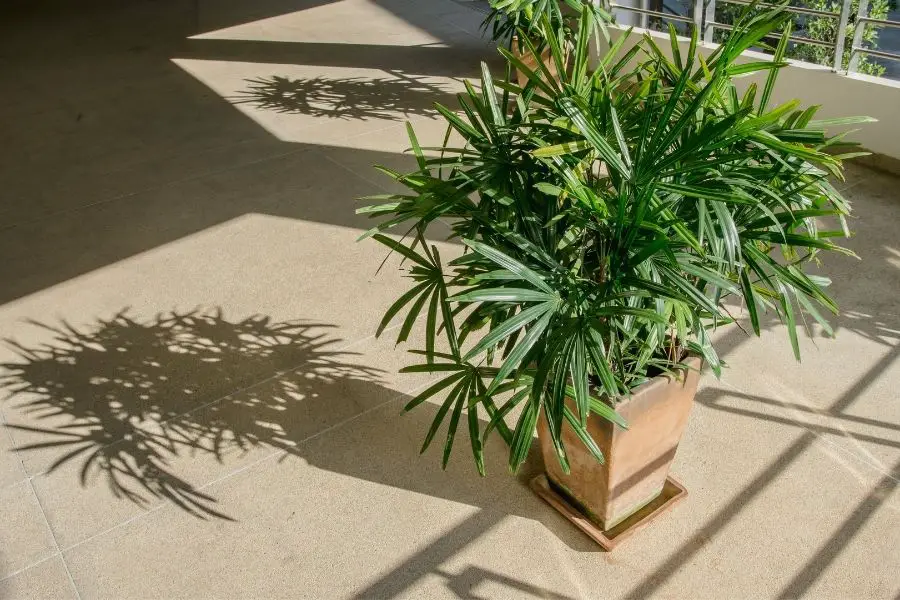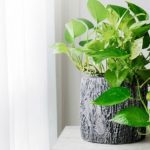- TEMPERATURE: 65 – 75 degrees F (18 – 24 degrees C)
- LIGHT: Low to Medium, Indirect
- HUMIDITY: Moderate
- SAFETY: Nontoxic to cats and dogs
- DIFFICULTY: Easy
Lady Palm (Rhaphis excelsa) can reach up to 10 feet (3 meters) in height outdoors. When grown as a houseplant, this palm can be kept as small as 14-inches (35 cm) by limiting its container size. You can basically grow it to any size you like – from a large tree to a small bonsai plant.
Easy to grow indoors, lady palm adapts well to limited sunlight. This makes it an ideal indoor tree for low light areas. It also tolerates neglect and doesn’t lose its attractiveness if you forget to water it once in a while.
Native to China, the plant has beautiful dark-green, fan-shaped leaves with naturally uneven edges. It’s a great choice for anyone who wants a formal, easy to maintain houseplant with an Asian vibe.
Water
Water plants by soaking the soil thoroughly – making sure it drains well. In summer, allow the soil to dry within 1 inch (2.5 cm) of the surface between waterings. In winter, allow the soil to dry within 2 inches (5 cm) of the surface between waterings.
Lady palms, like most other palms, are sensitive to fluoride and other chemicals in tap water. For the best results, water them with filtered or distilled water.
Humidity
Mist your plant daily with a water bottle set to the mist setting or use a handheld mister. Lady Palm requires moderate to high humidity levels. For the best results, place the pot on a humidity tray (see my post on how to make a humidity tray), and/or place a good houseplant humidifier in the room.
If you’re unsure about humidifiers, you can read my review of my favorite houseplant humidifier (the one I’m using right now) or click here to view it directly on Amazon.
Fertilizer
During the summer months, feed your lady palm once a month with a balanced houseplant fertilizer diluted to half strength. Do not feed in fall through spring. This plant is sensitive to too much fertilizer.
My favorite fertilizer is Jack’s All-Purpose, but any all-purpose food will work. (Read my review of Jack’s Fertilizer to see why I love it so much.) I use it on all my houseplants, except those that need special nutrients like cacti and succulents.
Light
Filtered light from an east- or west-facing window is ideal for lady palm. (When grown outdoors, it requires 80 percent shade.) Although it can tolerate low light, it prefers medium light.
Lady palm is one of my favorite houseplants because it thrives even in my dark house. Just make sure it gets a little diffused light each day, and it will do well in most indoor environments.
Temperature
Daytime temperatures of 65 – 75 degrees F (18 – 24 degrees C) are best for lady palm. Although it can survive temperatures as low as 55 degrees F (12 degrees C), make sure it never dips below this or the plant may not recover.
Keep your lady palm away from cold drafts and heating devices (vents, heaters, wood stoves, etc). Try to keep temperatures consistent.
Potting
Plant your lady palm in a high-quality potting soil formulated for houseplants. I like this one by Happy Frog because it contains mycorrhizal fungi and beneficial soil microbes, but any good-quality potting mix will work.
Repot your lady palm every two years until it reaches the desired size. Then, repot only as needed to refresh the soil. When repotting to a larger container, choose one that’s 4 inches larger in diameter than the previous pot.
Propagation
Lady palm is propagated easily by division. The plant develops new upright stems from its rhizome. If you want to divide the plant, the best time is when you’re already repotting the main plant every two to three years.
Maintenance
The ends of lady palm’s leaves tend to brown. This can be caused by low moisture, but it’s hard to prevent and sometimes happens even if you’re doing everything right. Instead of cutting off brown leaf tips with scissors, rip them off to keep the plant’s naturally uneven edges.
You’ll also want to clean the plant’s leaves regularly to remove dust, dirt, and hair that builds up over time. Use a soft cloth or sponge to gently wipe both sides of the leaves with warm, soapy water.
Troubleshooting
Here are some common problems indoor gardeners have with lady palms and suggestions for how to fix them:
- Variegation Patterns Fading – If you have a variegated lady palm and notice the pattern is fading, this is most likely because you’re over-feeding it. Reduce feeding to once monthly during the summer months only with a fertilizer diluted to half strength.
- Leaves Turning Yellow – If the leaves of your lady palm are turning yellow, this is usually because it’s getting too much sunlight. Make sure your plant is not in direct sun. If you have it in a window, move the plant back a few feet or hang some sheer curtains to diffuse the light.
- Brown Leaf Tips – This usually means your plant is not getting enough water or the humidity is too low. Make sure you’re watering thoroughly when the top 1-2 inches of soil becomes dry. Increase misting, place your plant on a humidity tray, and place it near a humidifier to increase moisture in the air.
Where to Buy Lady Palm
Unlike some other expensive palms (I’m looking at you Kentia Palm), you can usually find lady palm for a reasonable price at local nurseries and stores with garden departments. You might want to call and ask around locally before looking online.
If you’re unable to find one locally, my favorite place to buy houseplants online is Etsy. At the time I’m writing this post, I see lady palms for as little as $30 available from numerous sellers. NOTE: Sometimes people misspell the botanical name as “Rhapis” instead of “Rhaphis” – so that might help you in your search.
I love buying plants from Etsy because I love supporting small growers instead of large, corporate nurseries. Plus, sellers there must pay extra attention to the quality of their plants to stay in business. I’ve bought numerous plants from the site and I’ve never been disappointed.





